Japanese peeling knives are almost impossible to get. Fortunately Marko Tsourkan makes such knives and I was able to get one. This is it.
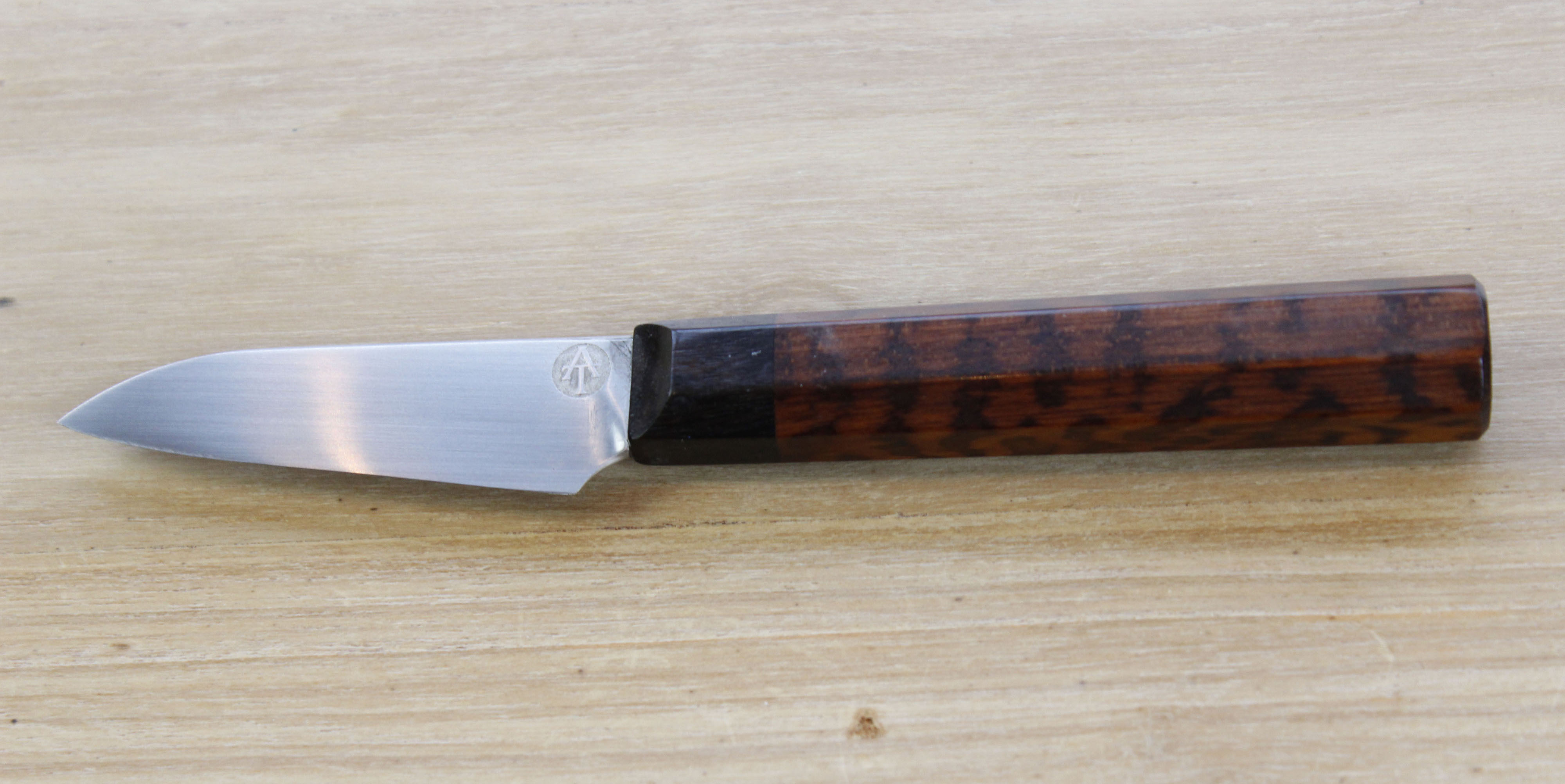
Looks and finish
To me the knife looks pretty good. The handle is made of snakewood, my favorite wood, and it even has a nice regular pattern. Unfortunately the blade has some scratches near the makers' mark.
The finish of the knife is good. The handle tapers towards the blade in a prudent manner. And the transition from the main part of the handle to the ferrule is almost impossible to feel. The ferrule fits the blade perfectly, so that fluids cannot enter the handle.
Something else that is noticeable is that the egde of the blade is not in line with the handle, but moves up slightly.
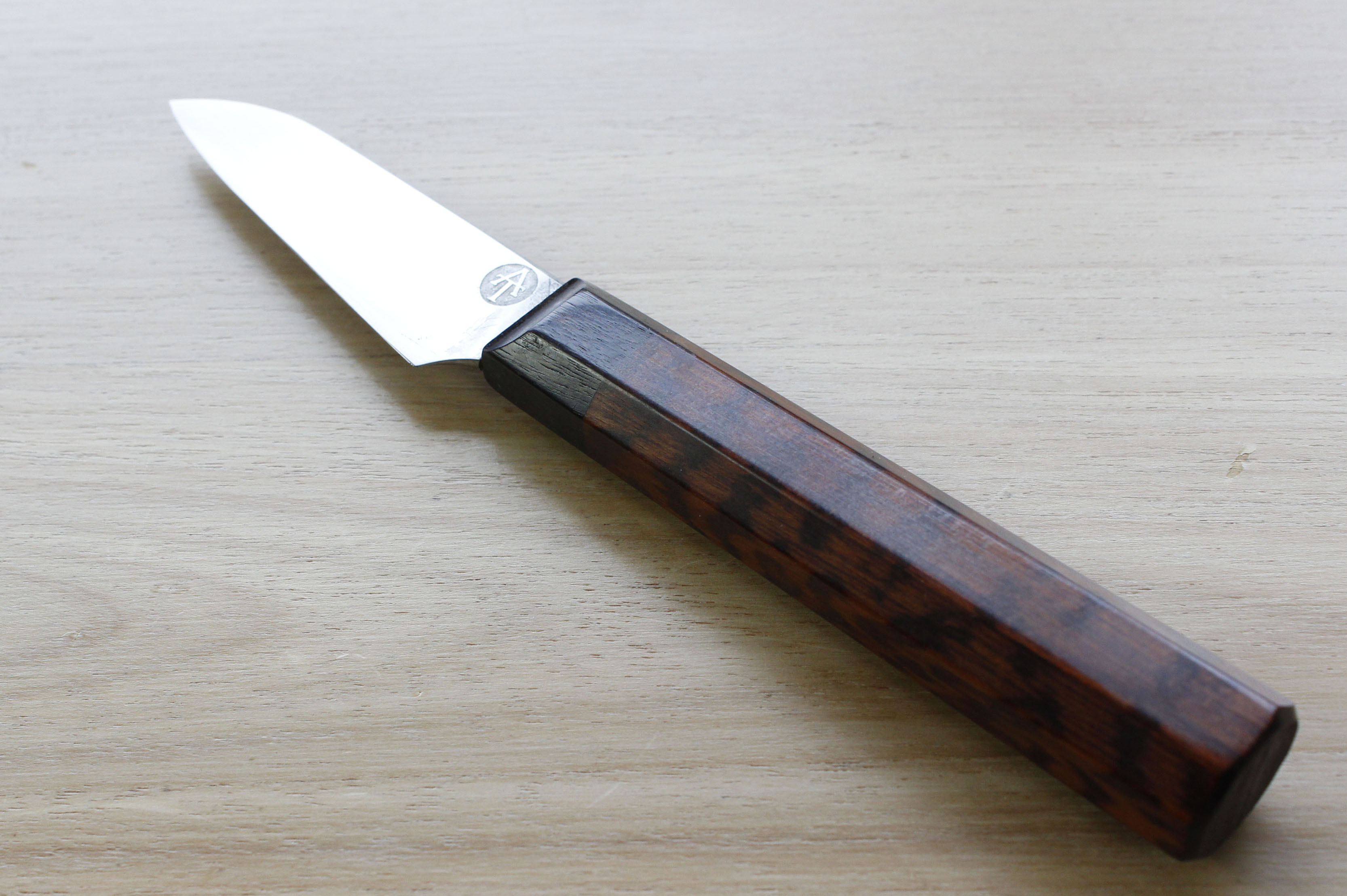
Profile and geometry
As I wrote, the blade moves up slightly from the handle. The edge of the blade is straight for the most part (as a peeling knife should be, in my opinion); only near the tip it curves up very little.
At the spine, the knife is 2.4 mm thick near the handle, but it tapers down quickly towards the edge. Halfway the blade it measures 1.5 mm. Just above the edge (half a centimeter) it measures only 0.4 mm.
To have some reference, I compared the knife to some cheap peeling knives that can be bought at a supermarket for EUR 1-2. See the knives below. The Tsourkan is about the same length as these supermarket lengths, in my view an ideal length.
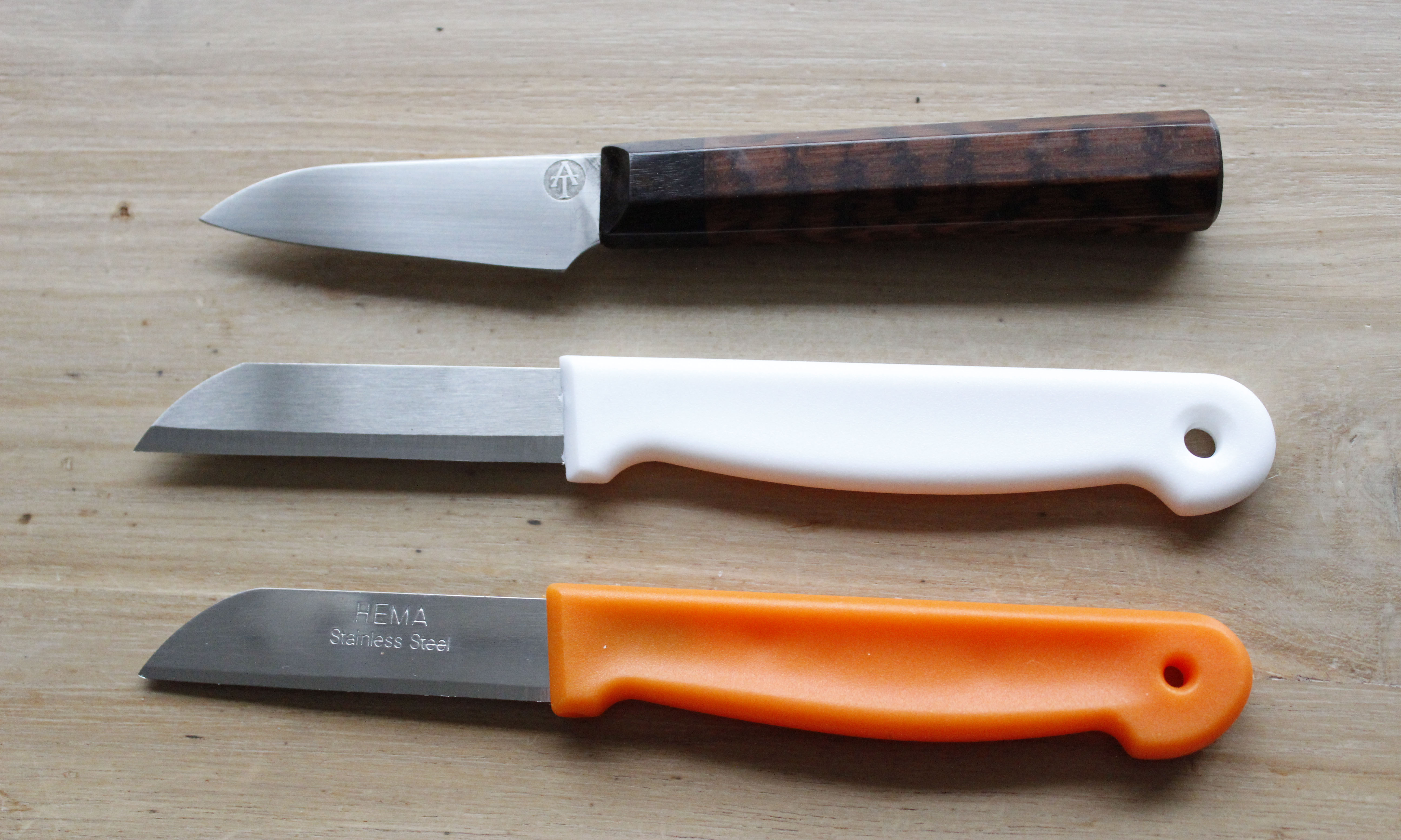
It should be noted that these cheap knives are made from plate steel and not forged. They have almost the same thickness over the entire blade. The thinnest knifethe white oneis 0.4 mm thick on average. This also applies to its thickness at the spine and the place 1 cm above the edge. The slightly thicker knifethe orange oneis 0.7 mm thick on average, which again also applies to its thickness at the spine and 1 cm above the edge.
I'm not saying these measures are idealboth the white knife and the orange knife have too much flex. (Some of these knives are not only very flexible, but have even warped.) But in general they do peel fine.
Use
I started by sharpening the Tsourkan. When it was delivered, I wouldn't call it blunt, but it was definitely not sharp. Out of rebellion I sharpened the knife on my Wicked Edge using stones and diamond films from 100 grit to 0.1 micron. I can assure you the knife was very sharp. And it cut very well. The thinness just above the edge certainly helped and the thickness at the spine posed no problem.
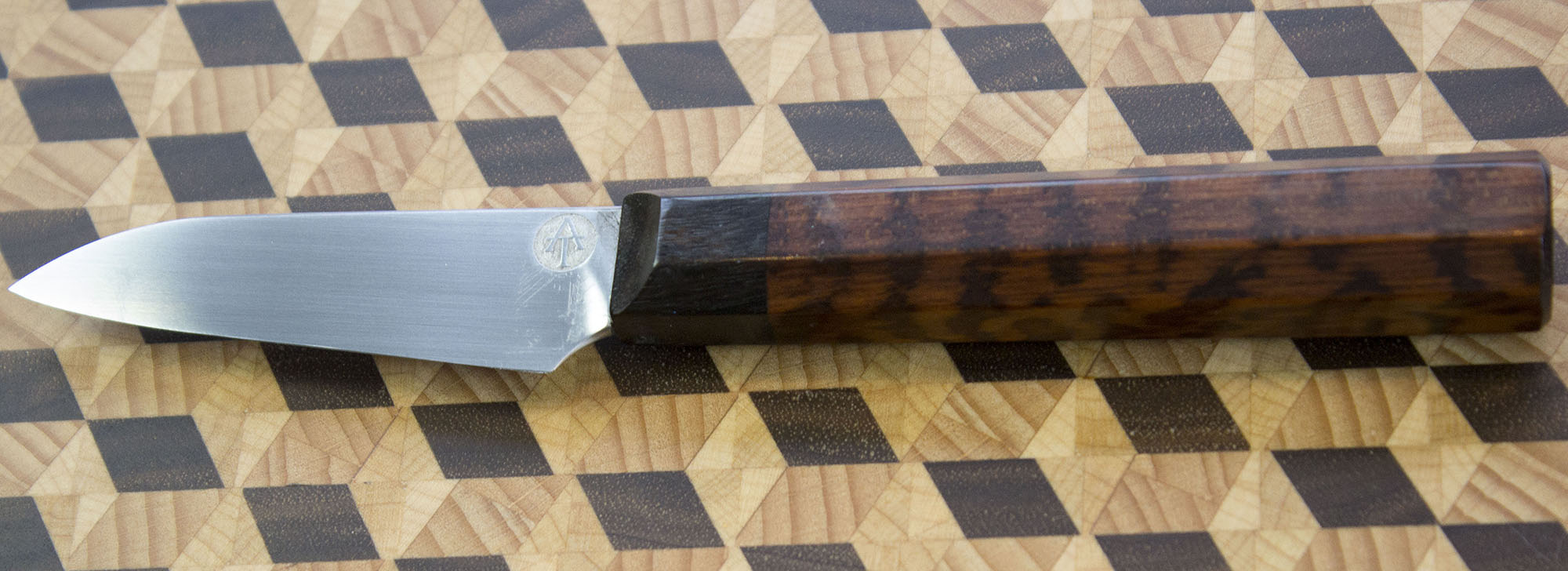
I peeled a lot of fruit and vegetables, including apples, potatoes, carrots, cucumbers and many more. I also cut a lot of cheese, something I often use my peeling knives for. I was very happy with its cutting performance.
Conclusion
I have thought long about buying this knife, but at the end I am very happy with it. It looks great, with the exception of a few scratches on the blade. But what really surprises me is that it, in spite of it being thicker than many other peeling knives at the spine, it cuts as well. In fact, it has less flexibility which makes cutting actually easier. It also has less flexibility, which makes cutting easier.
Factsheet
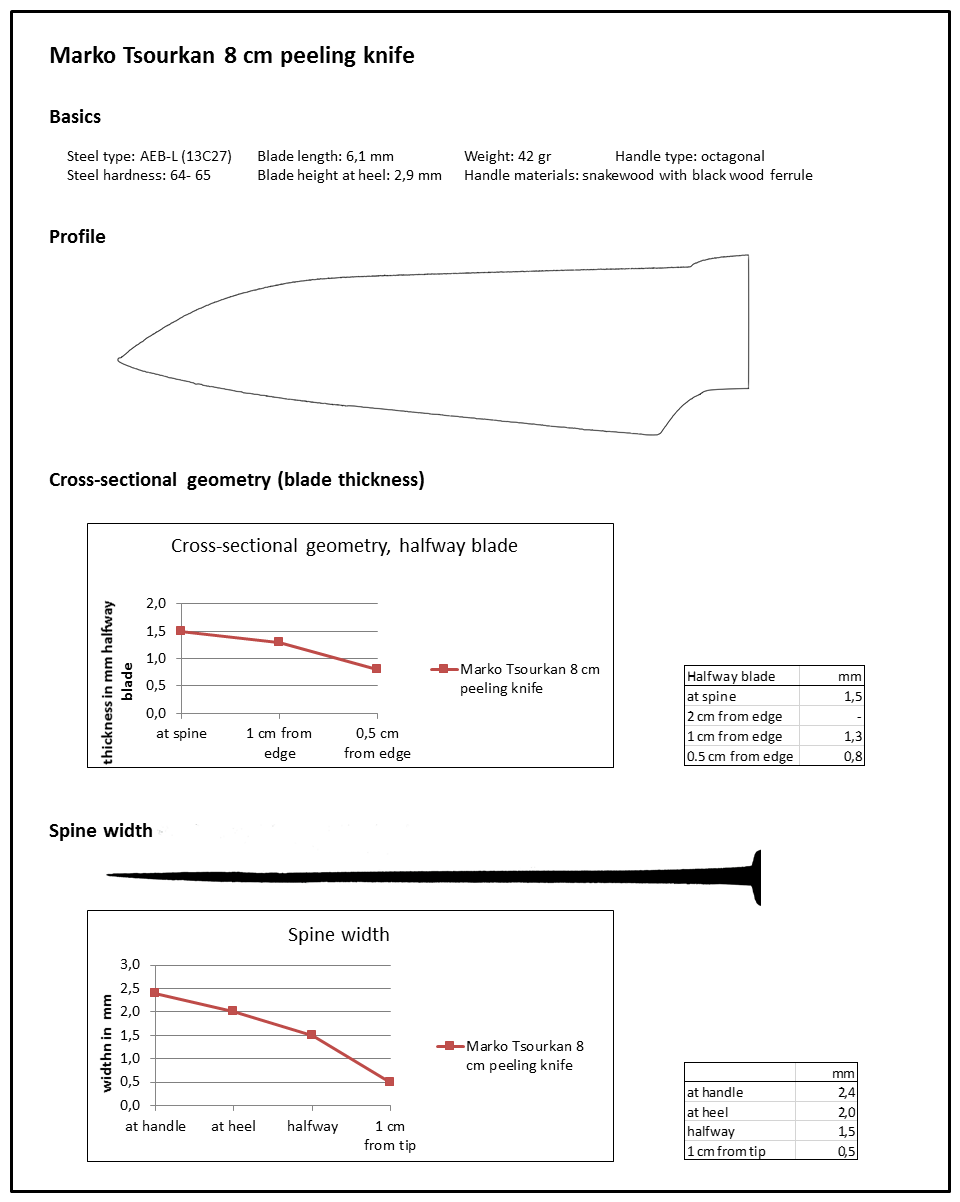

Looks and finish
To me the knife looks pretty good. The handle is made of snakewood, my favorite wood, and it even has a nice regular pattern. Unfortunately the blade has some scratches near the makers' mark.
The finish of the knife is good. The handle tapers towards the blade in a prudent manner. And the transition from the main part of the handle to the ferrule is almost impossible to feel. The ferrule fits the blade perfectly, so that fluids cannot enter the handle.
Something else that is noticeable is that the egde of the blade is not in line with the handle, but moves up slightly.

Profile and geometry
As I wrote, the blade moves up slightly from the handle. The edge of the blade is straight for the most part (as a peeling knife should be, in my opinion); only near the tip it curves up very little.
At the spine, the knife is 2.4 mm thick near the handle, but it tapers down quickly towards the edge. Halfway the blade it measures 1.5 mm. Just above the edge (half a centimeter) it measures only 0.4 mm.
To have some reference, I compared the knife to some cheap peeling knives that can be bought at a supermarket for EUR 1-2. See the knives below. The Tsourkan is about the same length as these supermarket lengths, in my view an ideal length.

It should be noted that these cheap knives are made from plate steel and not forged. They have almost the same thickness over the entire blade. The thinnest knifethe white oneis 0.4 mm thick on average. This also applies to its thickness at the spine and the place 1 cm above the edge. The slightly thicker knifethe orange oneis 0.7 mm thick on average, which again also applies to its thickness at the spine and 1 cm above the edge.
I'm not saying these measures are idealboth the white knife and the orange knife have too much flex. (Some of these knives are not only very flexible, but have even warped.) But in general they do peel fine.
Use
I started by sharpening the Tsourkan. When it was delivered, I wouldn't call it blunt, but it was definitely not sharp. Out of rebellion I sharpened the knife on my Wicked Edge using stones and diamond films from 100 grit to 0.1 micron. I can assure you the knife was very sharp. And it cut very well. The thinness just above the edge certainly helped and the thickness at the spine posed no problem.

I peeled a lot of fruit and vegetables, including apples, potatoes, carrots, cucumbers and many more. I also cut a lot of cheese, something I often use my peeling knives for. I was very happy with its cutting performance.
Conclusion
I have thought long about buying this knife, but at the end I am very happy with it. It looks great, with the exception of a few scratches on the blade. But what really surprises me is that it, in spite of it being thicker than many other peeling knives at the spine, it cuts as well. In fact, it has less flexibility which makes cutting actually easier. It also has less flexibility, which makes cutting easier.
Factsheet





